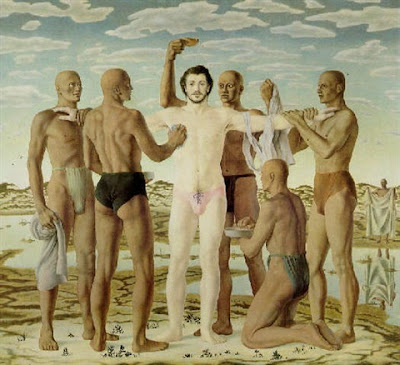The Lens: Notes on Thought and Vision.
Notes on Thought and Vision has never rated highly among HD scholars. Barbara Guest describes it in embarrassed terms as full of “super” terms, by implication, a little too elitist and Nietzschean; too much of it reading like DH Lawrence (God, forbid!) on his philosophical coal-heap. It is interesting to note that the strong intellectualism of the pamphlet is associated with maleness. Rachel Blau Du Plessis sees the book as a response to patriarchy, to the Promethean actions of HD’s brother. But Janice S Robinson seems to be closer to the truth when she aligns it with female intelligence. The intellectual assertiveness within Notes on Thought and Vision takes a male muse in female form as its driving force, HD’s lover, Bryher/Winifred Ellerman. (Bryer insisted that HD used “he” as a form of address). The sheer brain-power of Bryer, her reputation as an intellectual debater, offers a source much closer to home, for HD, than patriarchs such as Lawrence.
Because of its psychological nature Notes on Thought and Vision has been inevitably viewed in relation to Freud and Jung. Gelpi, in his introduction to the Peter Owen edition makes the point that Freud would have disliked HD’s terms, though they would have been much to the liking of Jung. This suggests an affinity that does not really exist. HD revered Freud—though they differed—and abhorred Jung as a thinker. Trying to twist HD’s thought into patriarchal lines is never wise and one of the problems with Notes is that it stands as a corrective to the male tradition. Notes on Thought and Vision is HD’s only extended statement on poetical theory. And it is a very odd statement in relation to HD’s outer world. It bears no resemblance to the bombastic utterances of Pound…to Imagism…to Vorticism. It also differs from the Poundian view in a very significant way. For Pound, the artist was the “antennae of the race”. Cultural demise was caused by a lack of quality artists. For HD, there is a belief that the artists exist. Cultural collapse has come about because the many do not know how to decipher the dashes and dots of vision.
Notes on Thought and Vision, as HD acknowledges, began with childbirth. The trauma that followed the birth of her daughter created a heighted state of mind which led to the formation of her views. It is tempting to push Notes on Thought and Vision into the backward stream. And with some justification. Life and art were inseparable for HD. But this does not mean that the pamphlet, however odd it may seem, for whatever reasons, belongs to some hysterical stage of HD’s life.
Central to Notes on Thought and Vision is HD’s belief in the over-mind, a “jellyfish” state, a kind of lens which allows vision. This is complimented by another lens, the love-mind. These lenses, when adjusted, when operating in relation to one another, create the focus, artistic production and birth. Janice S Robinson writes intelligently of HD’s vision in Trilogy, especially the elements that make Tribute to the Angels. She observes that the second book is written in the key of Venus/love/the angel Annael. It is, however, written in a double-key, of war-love, Uriel-Annael. The two lenses of Notes and Thought and Vision, Uriel/over-mind and Annael/love-mind return in Trilogy to create an art of sublimation and transubstantiation. By writing about love in a time of war, HD intends to create in Trilogy (1944-46) what she sensed in Notes:
Man’s chief concern is keeping his little house warm
and his little wall strong.
(pp.41).
But the artist’s role is hermetic, and far-ranging, and born out of autobiography, which ought to be translated as self-life-writing. The walls of the self are not little when expanded by over-mind.



Comments